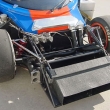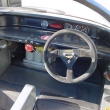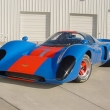1969 Chevron B-16
The Chevron marque was the brainchild of designer Derek Bennett. He drove his first Chevron design, the Chevron B1, in a Clubman Formula event on July 3, 1965 where he finished first, the start of a long history of success.
The Chevron B16 was an evolution of the B8 which had been Bennett’s GT car for three years, evolving over time to meet his customer’s needs. He wanted to put all the knowledge he had acquired over that time into a new car and began work on the B16 prototype early in 1969.
The B16 spaceframe chassis is reinforced with steel and duraluminum sheeting to form a full monocoque in the central section. Tubular frames were attached to carry the front suspension, mid-mounted engine and the gearbox unit. Bennett continued with his philosophy of keeping cars simple but refined enough work to their maximum, and the B16 includes no major technical innovations, but for ease of maintenance it did have a removable front subframe. Suspension is by doubled wishbones at the front and upper link and triangular wishbones at the rear. The B16’s body shape is basically Bennett’s design but he called in the help of stylist Jim Clark, an employee at Specialist Mouldings, to help him with the final details of the shapely fiberglass body.
For the engine, Bennett went to Cosworth, whose 1598 cc FVA Formula 2 engine had powered the B8. Bennett wanted the engine increased nearer 2 litres and Keith Duckworth, Cosworth’s main engineer, could see there was a place in the increasingly popular sports car scene for this size engine. So, using a different crank and longer stroke they increased the FVA’s capacity to 1790 cc, giving 245 bhp and designated it the FVC.
Bennett’s eagerly awaited Chevron B16 made its debut at a test session at Aintree in July 1969, where it ran within the lap record. From this promising start, and another excellent outing at Croft, Bennett decided the B16’s first official event should be at the Nurburgring 500 km race on September 7, 1969. The B16 was driven by Brian Redman and powered by a Cosworth 1600 cc FVA Formula 2 engine. The combination worked well and the B16 qualified on pole, a massive 5.6 seconds faster than the nearest contender. Redman led the race from the start and during the three and a half hour event, never lost his position. The combination had worked, Chevron was victorious.
After such as amazing start, other drivers came looking for a B16 but many found it hard to drive with its huge amount of understeer. The real problem was tat there was not enough downforce at the rear, so the B16 gained the two orange box rear spoilers it would have when it went into proper production. Regardless of these problems, orders were still flooding in. The B16 did not race in England until March 15, 1970 and did not win until two weeks later when John Burton won a round of the RAC British Sports Car Championship. Chevron began looking to the new European 2 litre Sports Car series. The extremely talented Redman was again the B16 driver, and the team was enthused until they got to the opening and saw the brand new Lola T210. Redman knew he would have to work hard during the race and he and the Lola were soon separated from the rest of the pack. Redman fought all the way, and after the Lola took an unexpected pitstop for fuel, he went on to victory. After battling against the Lola many times, and losing, Redman begged Bennett for an open car. It was an inevitable request, and as the initial order rush for the B16 had subsided, Bennett was now able to work on an open version.
The B16 coupe is one of the best looking race cars ever built and it still has the same ‘wow’ factor as it did then. The car is beautiful and its long, flowing lines are amazingly graceful. The Chevron Coupe formerly in the Mathews Collection was one of only 23 cars built and was very successful in endurance racing.





